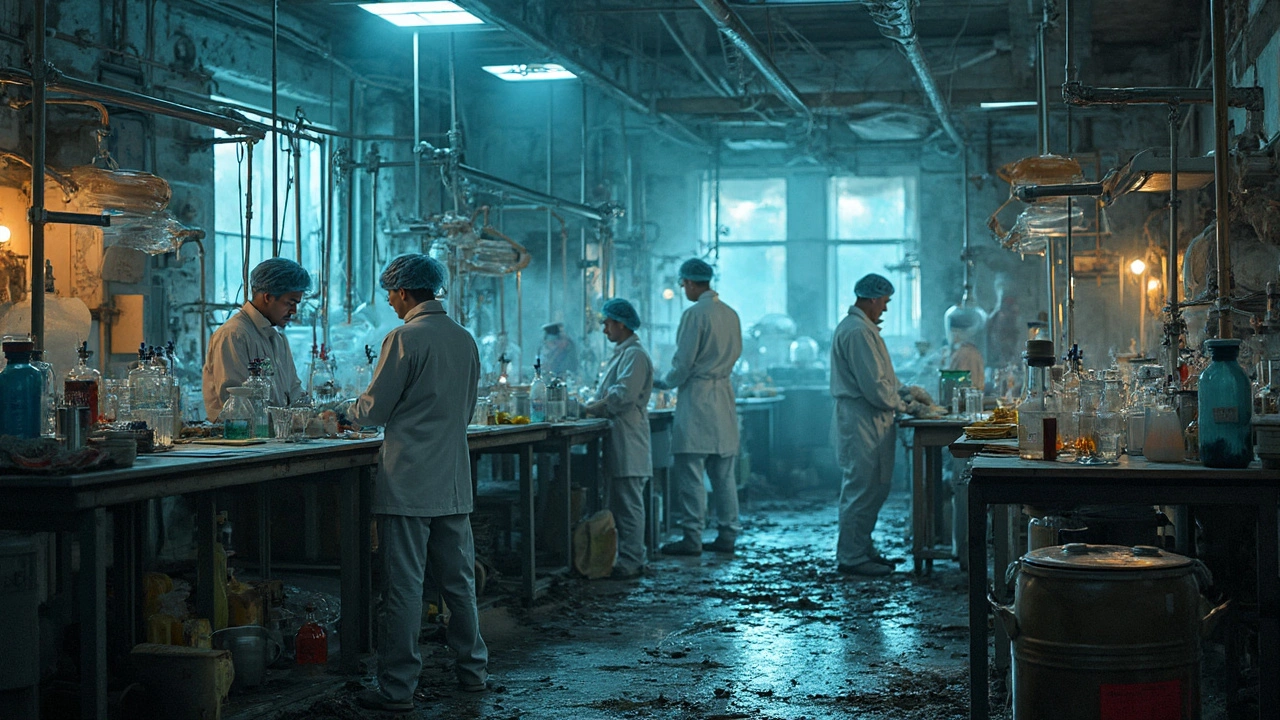If you’re taking doxepin or thinking about it, you’re probably focused on how it helps with sleep or mood. But there’s another side to that small pill—how it gets made before it ends up on your nightstand. Turns out, making doxepin has some real effects on the environment that most people never hear about.
The process isn’t just mixing a couple of ingredients in a lab. It involves several steps using chemicals, water, and energy. Some of the leftovers—called pharmaceutical waste—don’t just vanish. They can end up in water, the air, or even back in our soil.
Companies are under pressure to step up and clean up, but changes don’t always happen overnight. Even the way you get rid of old doxepin at home can make a difference to the planet.
- How Doxepin Is Made
- The Dirty Side Effects of Production
- Waste and Water Worries
- Steps Toward a Cleaner Process
How Doxepin Is Made
People usually don’t think about where doxepin actually comes from, but it starts in a chemical factory, not in a field or garden. Labs produce doxepin by running a series of chemical reactions that build its main structure from smaller pieces. It’s nothing like brewing coffee or making bread. Here, everything happens with solvents, acids, and precise temperature controls.
The main steps look something like this:
- Mixing up a starter chemical called dibenzoxepin, which is the backbone of the doxepin molecule.
- Reacting it with another compound to add those special groups that make doxepin work for depression and sleep problems.
- Purifying the result using big batches of organic solvents and water.
- Crystallizing the doxepin to get it into a solid, stable form for pills and capsules.
This process uses a ton of water and chemicals—sometimes more than 10 liters of organic solvents just to make a kilo of doxepin. Think about that the next time you see a blister pack at your pharmacy. All that chemistry has a cost, and it doesn’t just disappear.
Here’s a quick look at what usually goes into producing one standard batch:
| Item | Typical Amount for 1 kg Doxepin |
|---|---|
| Organic solvents | 10-12 liters |
| Process water | 500-700 liters |
| Energy used | 300-400 kWh |
Each batch is closely monitored because even tiny slip-ups can lead to unwanted side products—stuff that not only wastes resources but also creates more pollution to handle. That’s why making doxepin isn’t just about the final pill. The way it’s made matters too, especially if you care about environmental impact and what happens out of sight.
The Dirty Side Effects of Production
When it comes to making doxepin, pharmaceutical companies use a bunch of chemicals, solvents, and plenty of water. It's not just about mixing things together. Some steps produce byproducts that don't just disappear, and this is where problems start building up outside the lab.
One big headache is chemical waste. The leftover solvents and reaction byproducts can be harmful to both water and soil if they're dumped or leaked. For example, common chemicals used in the synthesis process, like acetonitrile or dichloromethane, are flagged for being pretty rough on aquatic life. If waste handling isn’t spot on, trace amounts make their way into rivers and lakes, hurting ecosystems.
It’s not just water. Making doxepin also pumps out air pollutants, thanks to the energy required and the release of volatile chemicals. These can contribute to smog and poor air quality around production sites. And don’t forget about carbon emissions—every step, from raw material shipping to the factory floor, adds up. Estimates say that pharmaceutical manufacturing makes up about 3% of global greenhouse gas emissions, putting them on par with the airline industry.
Even packaging matters. Excessive plastic, foil, and cardboard that end up in the trash are part of the dirty footprint. And if medications expire, improper disposal means extra chemicals might leak into landfills or water systems.
| Environmental Concern | Doxepin Production Impact |
|---|---|
| Water Pollution | Risk from process wastewater, trace solvents |
| Air Pollution | Volatile organic compounds, increased CO2 |
| Soil Contamination | Chemical spills, waste mismanagement |
| Waste Generation | Pills, packaging, byproducts |
All this means that the environmental impact of doxepin production runs deeper than most people think. The real challenge is finding ways to cut these side effects without making the drug harder to get—or more expensive.

Waste and Water Worries
Here’s where things get messy. The production of doxepin kicks out a bunch of chemical waste, including leftover solvents and byproducts that aren’t easy to filter out. These chemicals don’t just evaporate or disappear—they often get dumped down the drain (legally or not) and end up in rivers, streams, or groundwater. That means traces of doxepin can sneak into drinking water supplies or hang around in the environment long after you swallow your last pill.
In a real-world study of pharmaceutical waste in Europe, doxepin and similar compounds showed up in river samples at levels high enough to worry fish and local wildlife—even at tiny concentrations. Why? Because even small bits of psychiatric meds can mess with hormone balances in fish or stop them from breeding normally. Multiply that by thousands of pills made every day, and you can see why this matters.
The water isn’t the only thing at risk. Wastewater from doxepin factories often contains ingredients that basic treatment plants just can’t handle. That means water released back into the environment can carry medication leftovers with it. Here’s a quick peek at some typical numbers:
| Substance | Avg. Level in Wastewater (μg/L) | Standard Treatment Removal Rate |
|---|---|---|
| Doxepin | 8.2 | 25% |
| Solvents | 35 | 30% |
| Byproduct A | 5.1 | 40% |
A lot of this waste eventually settles in sludge, which sometimes gets spread on farmland. That means tiny amounts of these substances can make it from factory waste, to water, to soil, to food. Doesn’t seem like much, but it builds up.
If you have old doxepin or unused pills, tossing them in the sink or trash only adds to the problem. Try to find a local pharmacy take-back program—these actually keep medications out of water and landfills.
Steps Toward a Cleaner Process
If you care about the environmental impact of doxepin production, you’ll want to know about the steps companies are starting to take. Making medicine doesn’t have to wreck the planet. More drugmakers are facing pressure from both the public and regulators to go greener. Here’s what’s actually changing:
- Greener Chemistry: Some factories are swapping out harsh solvents for ones that break down safely in nature. For example, water-based and plant-based solvents are on the rise. This switch cuts down on toxic waste and chemical spills.
- Closed-Loop Systems: Instead of dumping leftover chemicals, some companies are setting up closed systems. These capture and reuse chemicals, which means way less pollution and lower costs down the line.
- Wastewater Treatment: Cleaning up water before it leaves the factory is a must. Modern plants use advanced filtration and even bacteria to eat away at the nasty stuff that would otherwise end up downstream.
- Energy Smarts: A lot of energy gets burned making doxepin. Some companies now use solar panels or more efficient machines to shrink their carbon footprint.
- Responsible Sourcing: Businesses are getting pickier about suppliers, choosing those that follow good environmental practices themselves. No one wants upstream pollution coming back to haunt them.
Check this out for some perspective on how changes are adding up:
| Change | Average Waste Cut (%) |
|---|---|
| Greener Solvents | 30 |
| Closed-Loop Recycling | 50 |
| Upgraded Water Treatment | 70 |
Even consumers play a role. Ask your pharmacy or doctor about safe medicine take-back programs instead of just trashing or flushing old doxepin. Waste tossed the wrong way can push those chemicals right back into water supplies.
It’s not a perfect system yet, but if pharmaceutical production sticks with these changes, we could see a huge drop in pollution tied to medicines like doxepin. The more folks know and speak up, the more progress we’ll see.


Travis Evans
Wow, this is a real eye-opener! I always thought medications like Doxepin were just about helping folks, not about all these environmental nightmares behind the scenes. It’s kinda wild how something designed to improve our mental health can leave such a footprint on the planet.
It makes me think: what can we as users actually do? Beyond just taking meds responsibly, is there a push for greener pharmaceutical manufacturing? Could we be nudged to recycle or dispose of leftover meds differently? I’m all in for making smarter, greener choices but sometimes it feels like we’re at the mercy of giant corporations and laws.
Also, this definitely adds a layer of complexity when considering natural vs synthetic treatments. The environmental cost is another factor that could tip the balance for some people.
Kudos for bringing this to light. Awareness like this can spark conversations and, hopefully, real change. What do you guys think about the role of pharmaceutical companies here? Should they be held more accountable or do we need more consumer pressure?